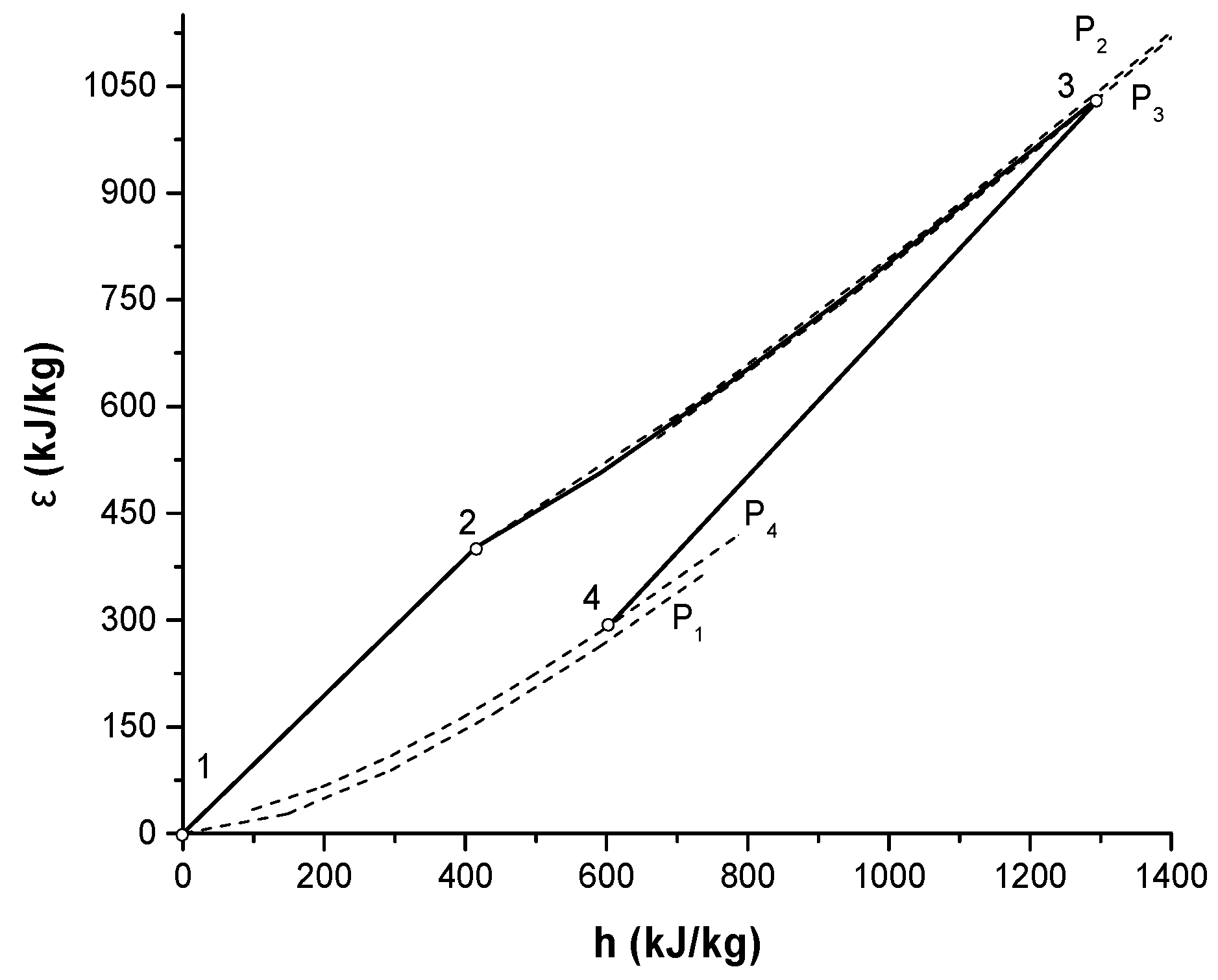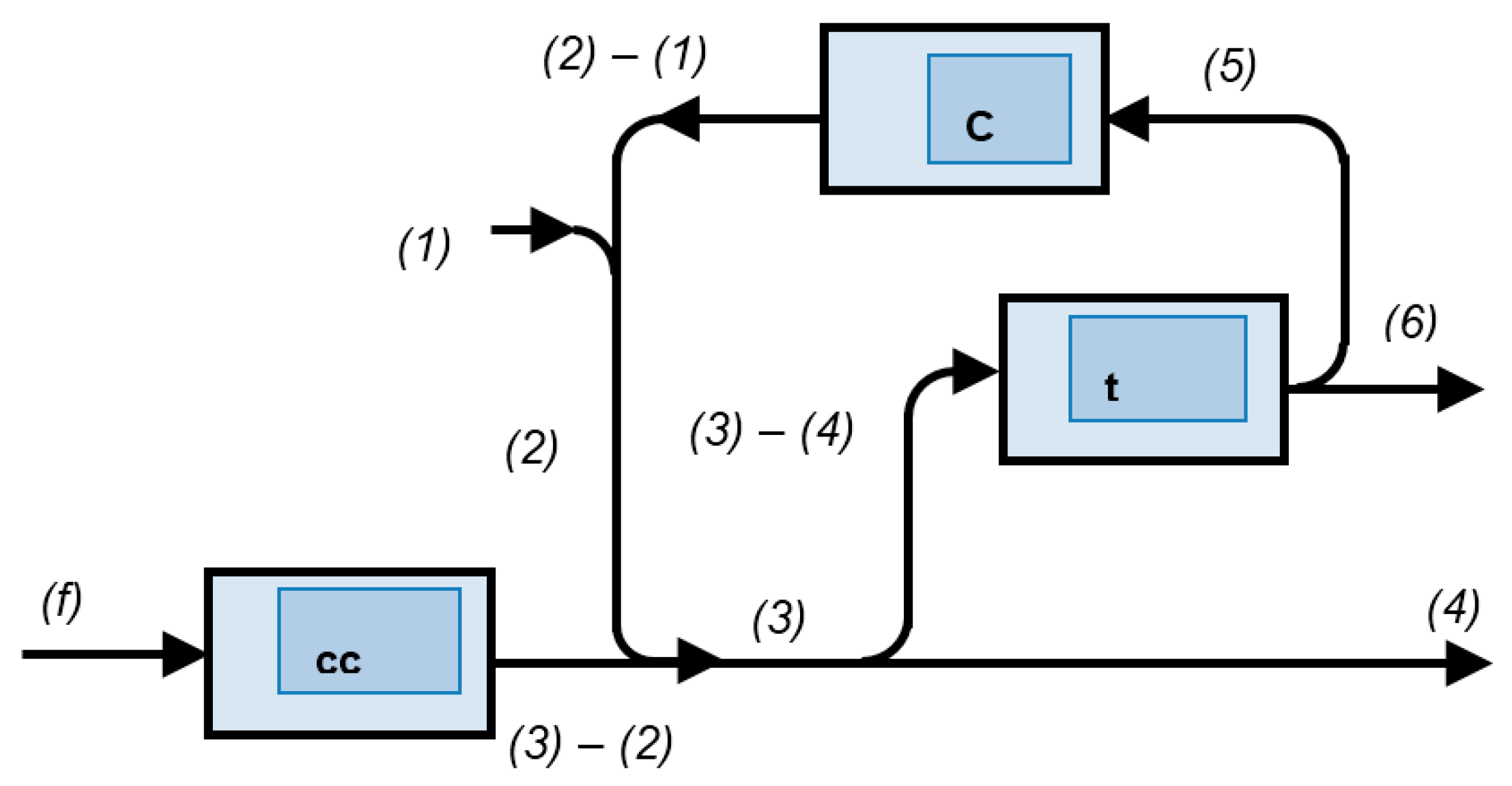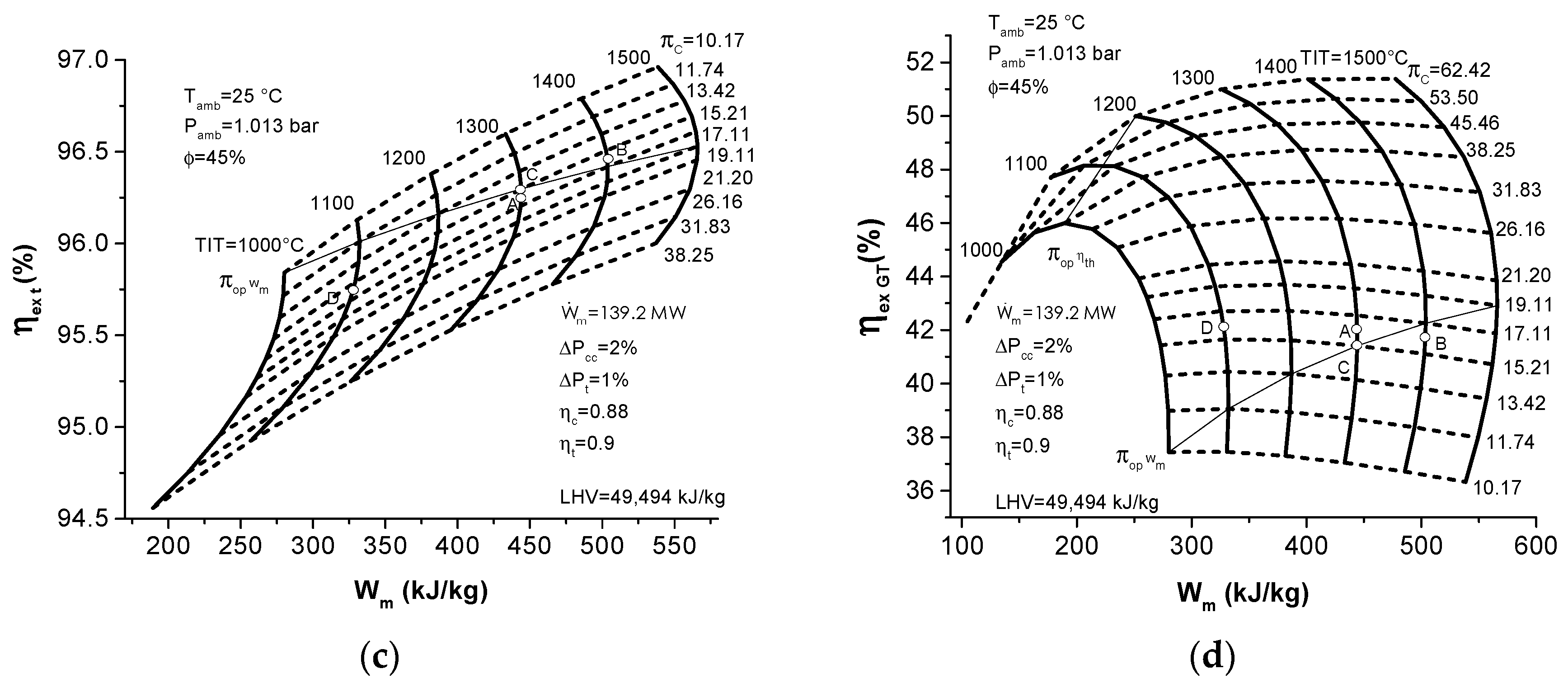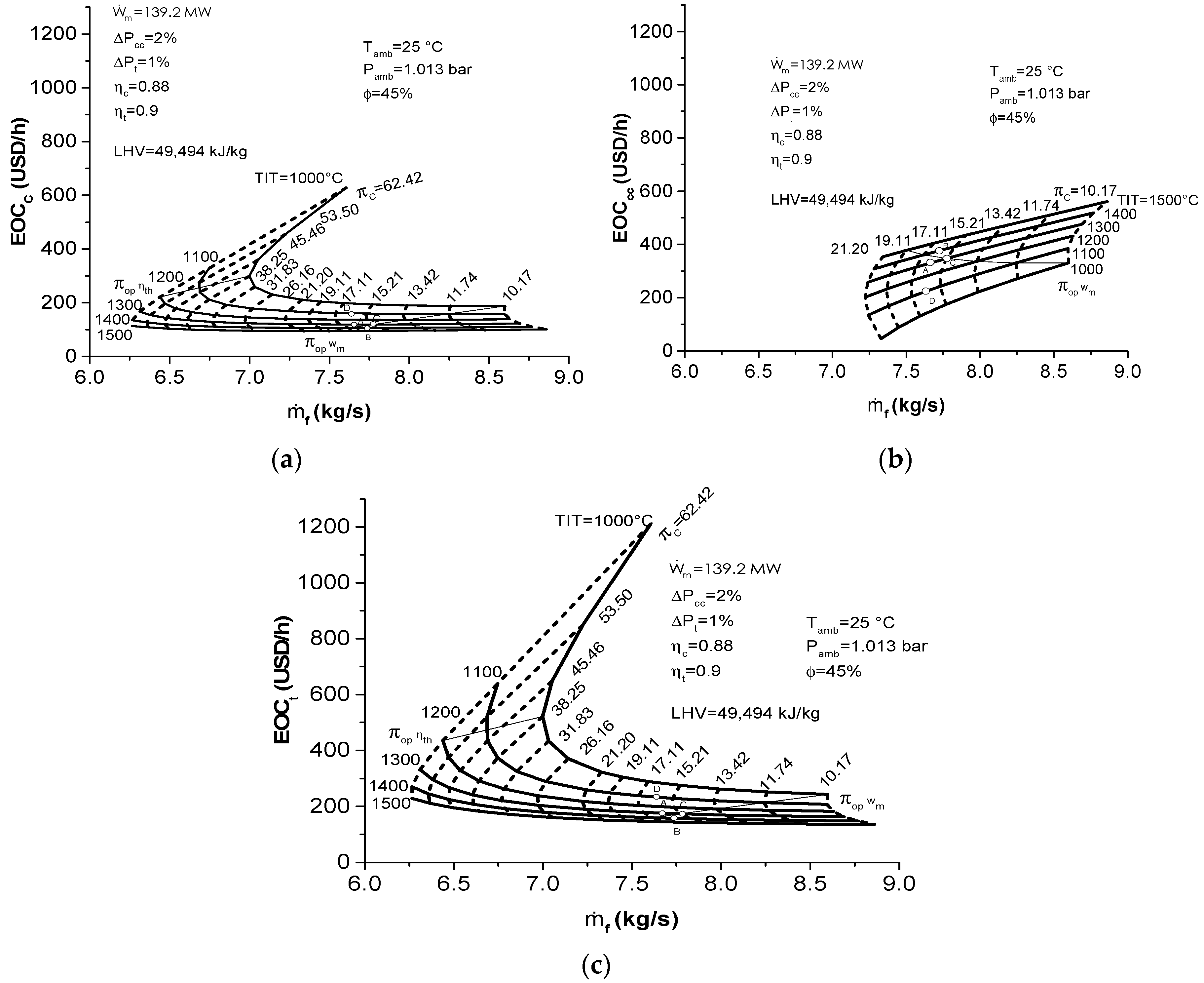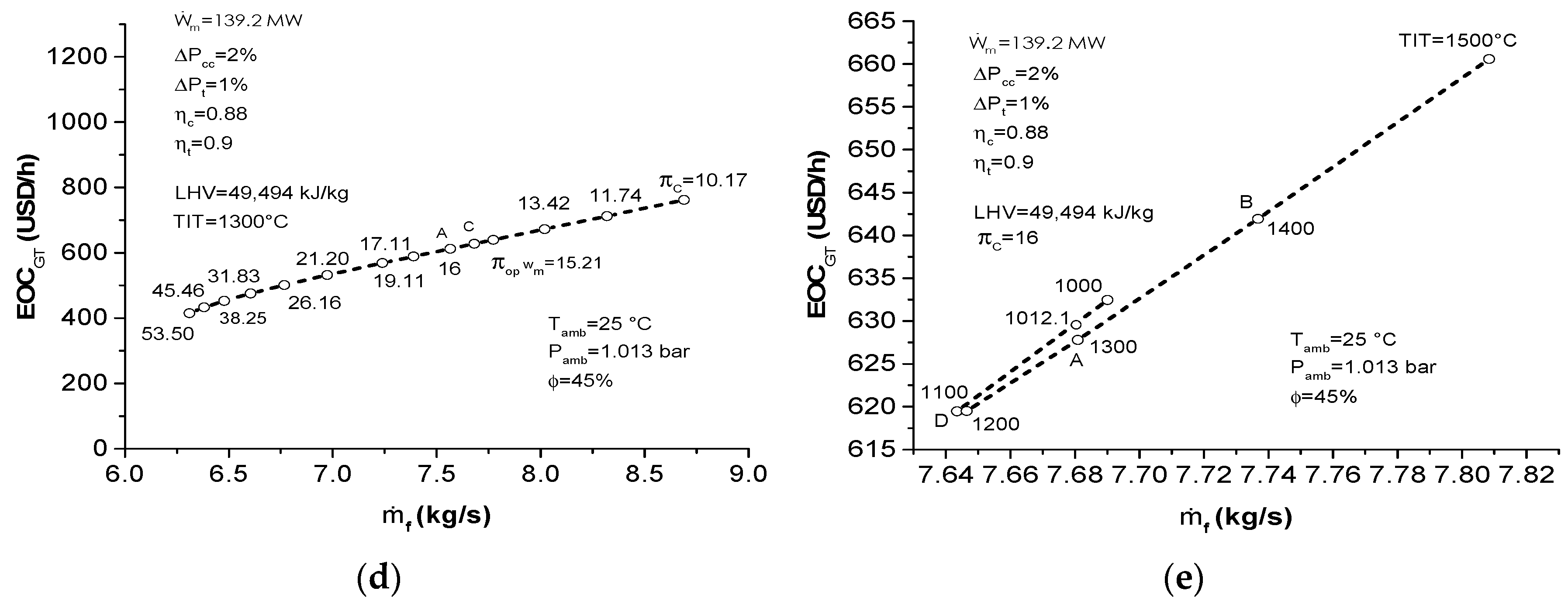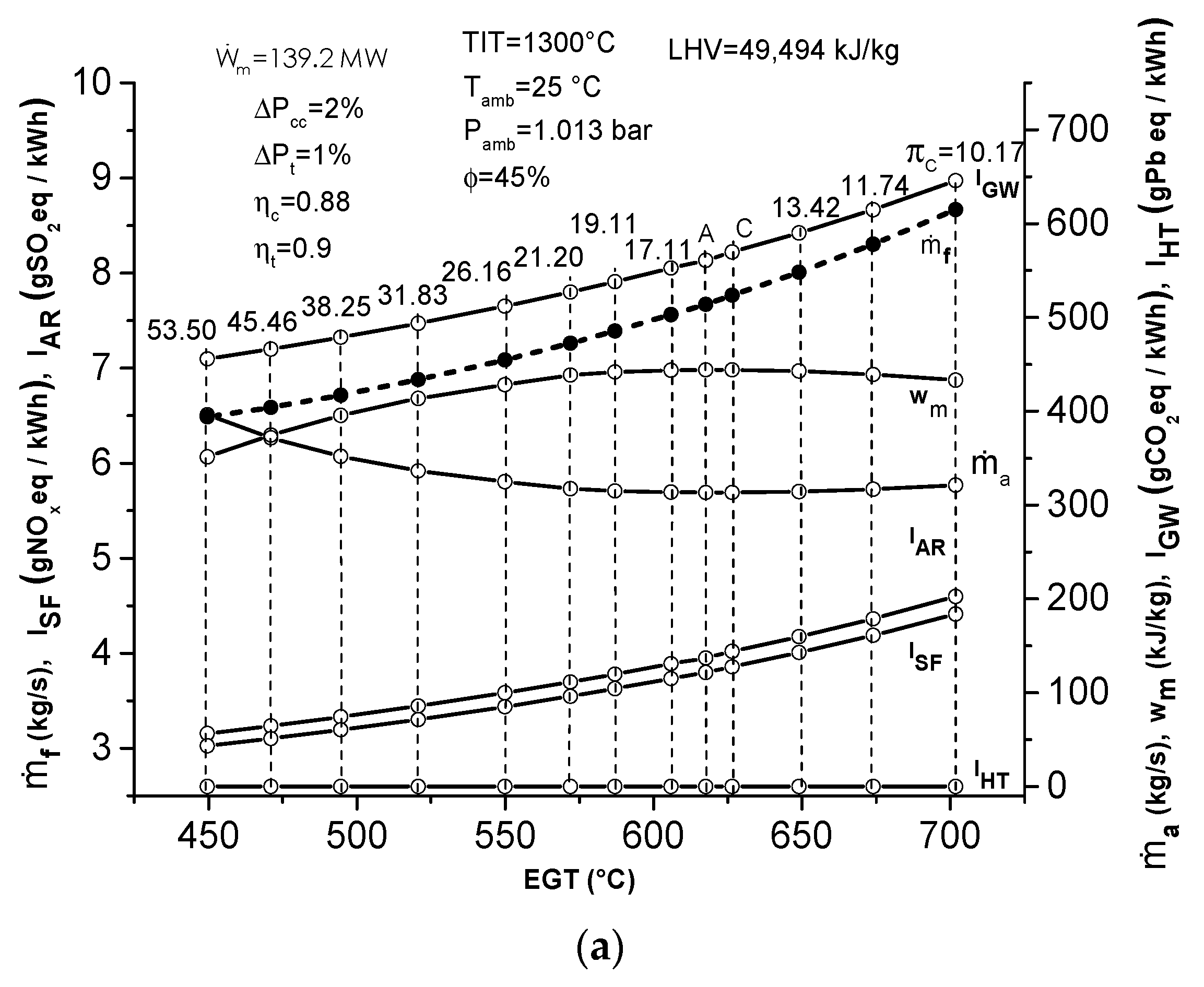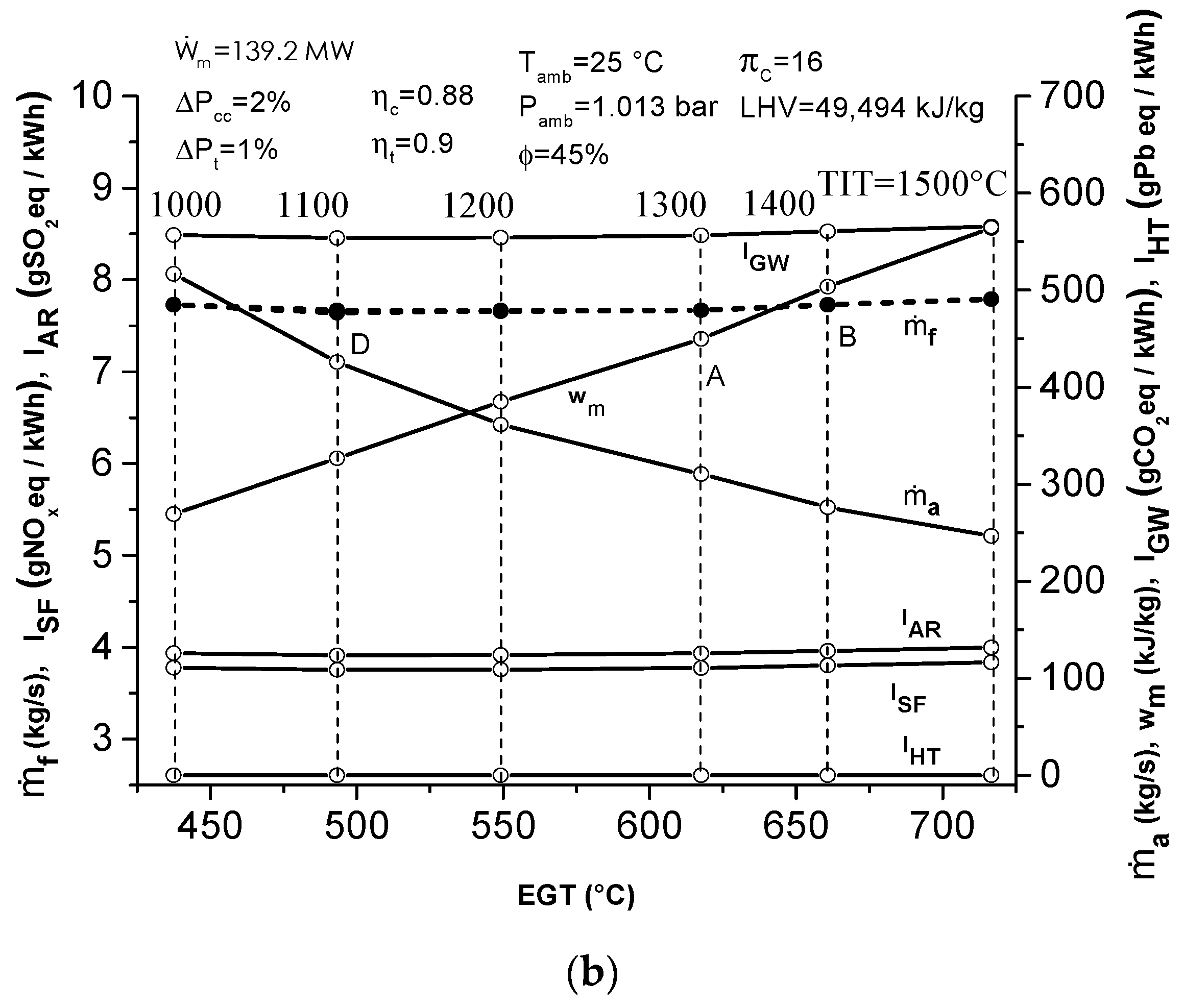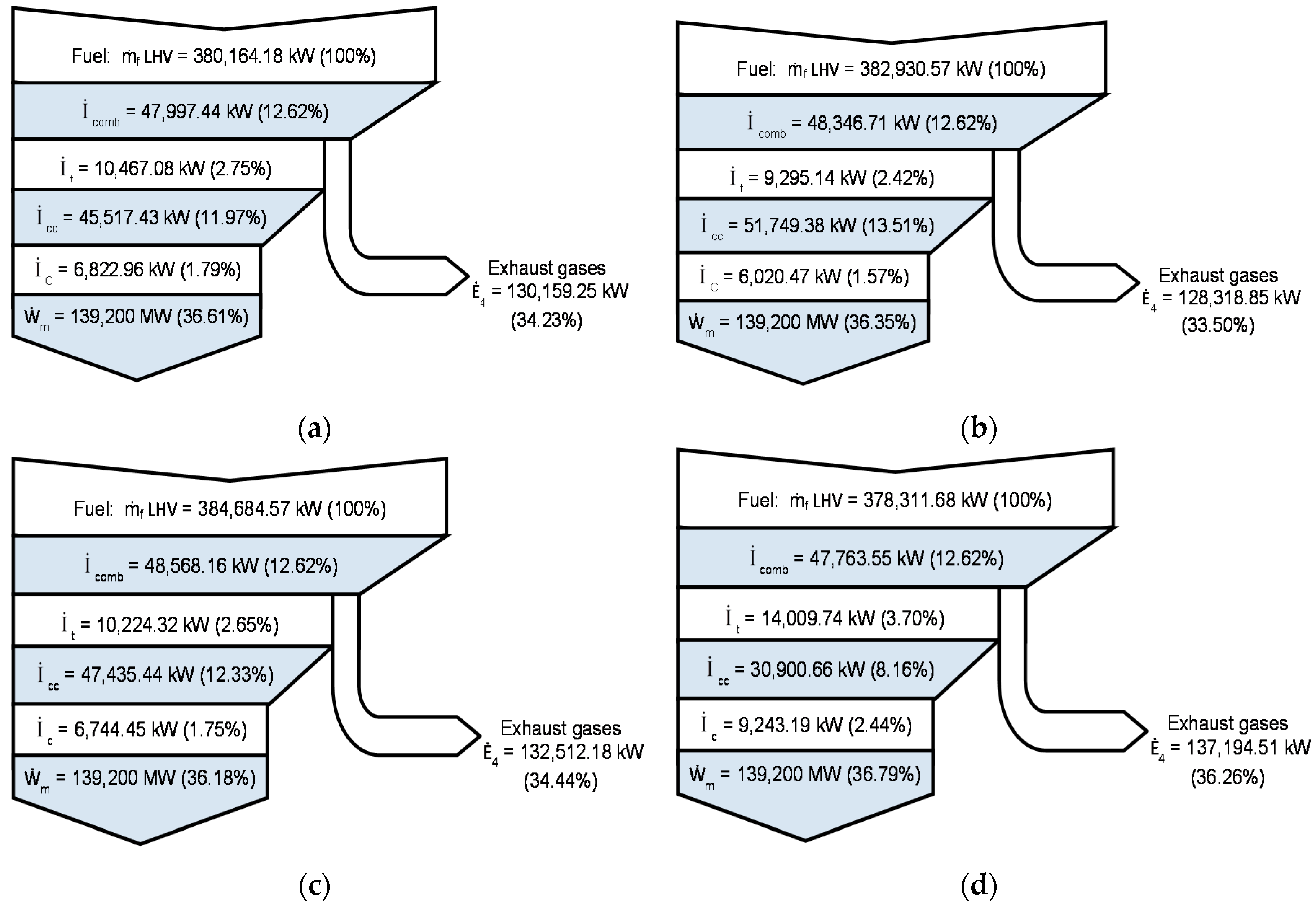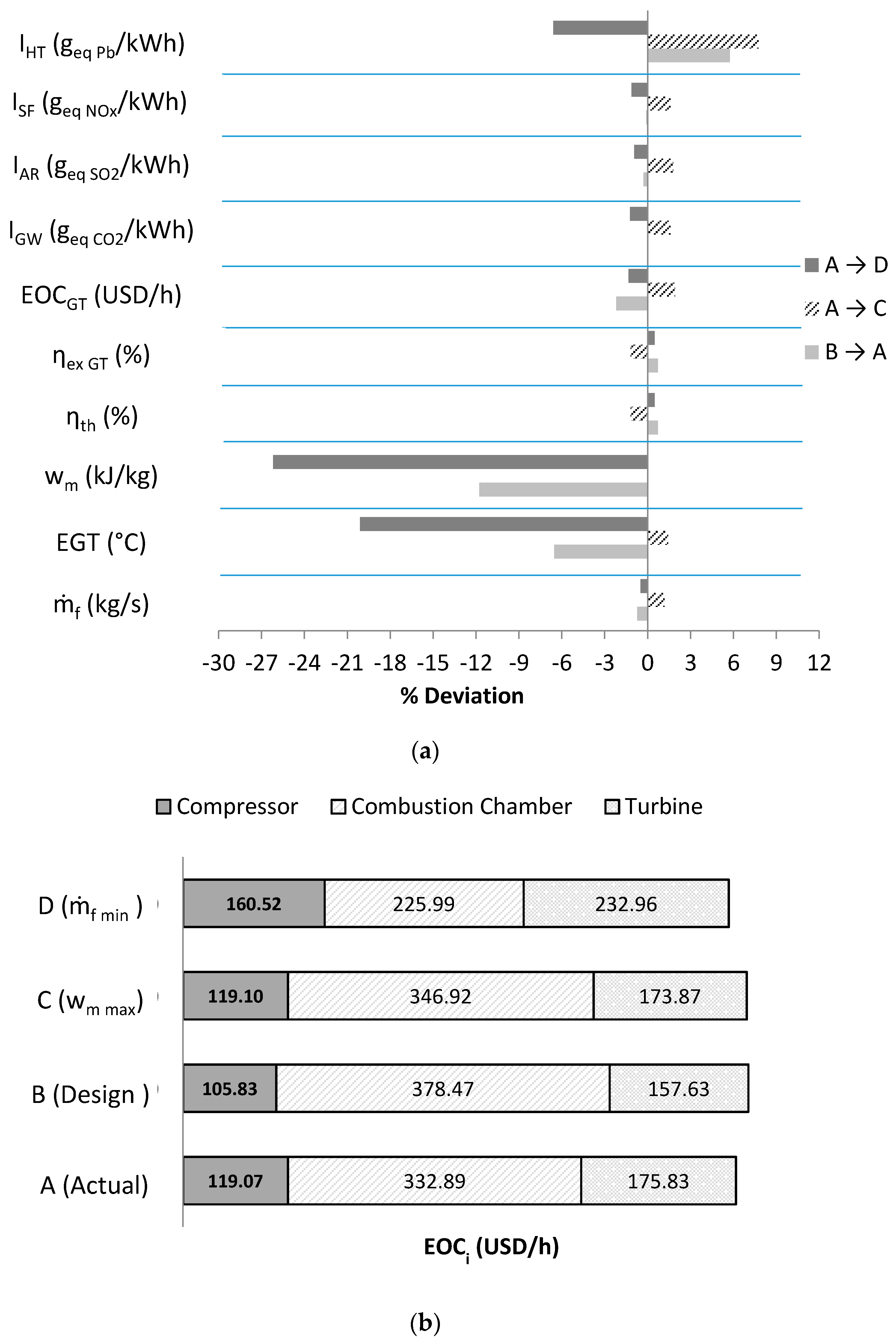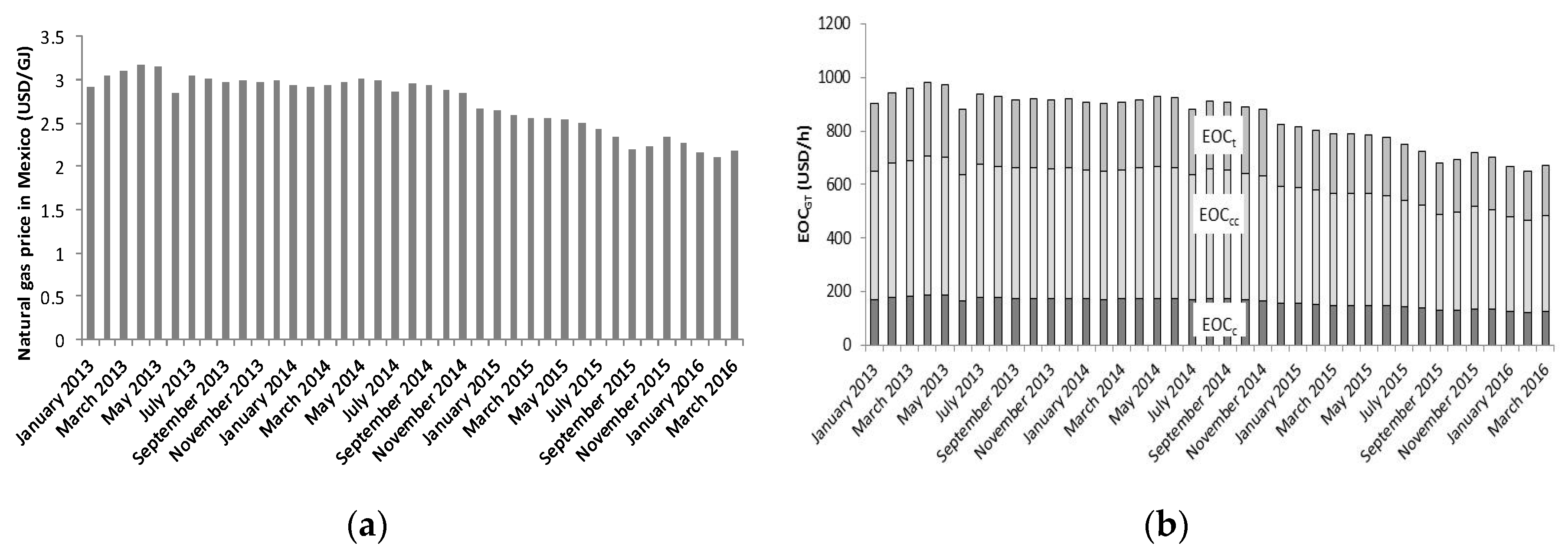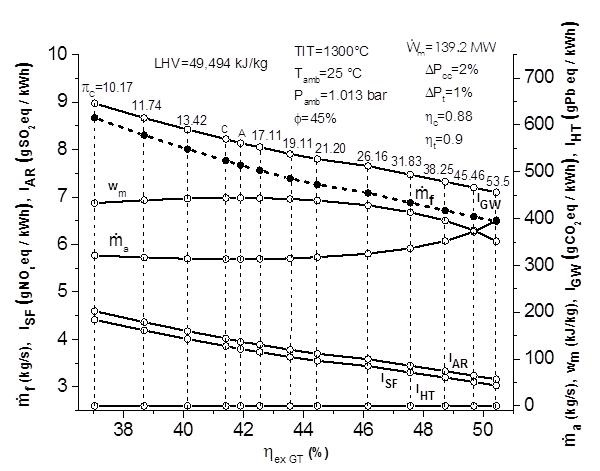1. Introduction
Gas turbines have become a core technology for converting the chemical energy of fossil fuels into shaft work used to mechanically drive compressors, pumps, and electrical generators in the industries of electrical power, oil and gas, iron and steel, and mining [
1,
2]. However, this conversion process produces a waste stream corresponding to the exhaust gases at high temperatures, which are released into the environment. The composition of these gases includes greenhouse gases such as steam, carbon dioxide, and methane; contaminant gases, for example, carbon monoxide, nitrogen oxides, and unburned fuels; and particulate material such as ashes. This stream is known as residue and its results are essential for evaluating the sustainability of the gas turbine operation, to establish recommendations to reduce the environmental impact of their operation, and to recover the energy content of the exhaust gases.
In Mexico, conventional thermoelectric power plants burn natural gas, carbon, or oil to generate steam, which is the working fluid of a steam cycle. These plants are repowered into combined cycle plants by coupling a gas turbine to the steam cycle of the conventional plant via a heat recovery steam generator. These different configurations involving a gas turbine provide or supply more than 50% of the electricity requirements, shaft work, or thermal power.
The new technologies improving the gas turbine performance are centered in the increasing of the turbine inlet temperatures in gas turbines by using new improved materials, blade cooling systems, and high thermal resistance coatings [
3]. Continuous innovation related to the gas turbine and its wide use makes research into these systems of still greater importance for all the industrial sectors mentioned above.
The power generation costs are mainly influenced by energetic, economic, environmental, and toxicity factors. There are different types of methodologies used to estimate the energetics costs of power generation plants. On the one hand, some of these methodologies are based on the application of the first and second law of thermodynamics, and include the works of Lugo et al. [
4,
5,
6], Kotas [
7], and Dincer et al. [
8], among others. On the other hand, there are also methodologies to estimate the power generation based on the exergoeconomic analysis of the gas turbine, which is the main subsystem of power plants, such as single gas turbine, combined cycle, and cogeneration plants, such as those pursued by Valero et al. [
9,
10], Tsatsaronis [
11], Bejan et al. [
12], and Torres et al. [
13]. The environmental impact of the power generation has also been studied by Hakan et al. [
14], Goran et al. [
15], and Dincer et al. [
8] by accomplishing environmental, sustainability, and exergoenvironmental analyses applied to power generation plants. However, these studies do not establish a synergistic analysis between the energetic, economic, environmental, and toxicity factors and the operating parameters of the power generation plant. From the background information, the present paper develops a parametric analysis of a Mitsubishi M501F3 simple gas turbine to relate energetic, exergoeconomic, environmental, and human toxicity indexes with the operation parameters, such as compressor pressure ratio and the inlet gas turbine temperature.
Lozano et al. performed a thermoeconomic analysis of gas turbine cogeneration systems with/without a regenerative heat exchanger. The main objective was to find the unit product exergoeconomic cost of the system [
16]. Karaali et al. realized a thermoeconomic optimization of four different gas turbine cogeneration plants configurations providing a power output of 30 MW and producing a steam flow of 14 kg/s [
17]. This study proves that the implementation of a heat recovery system increases the cycle’s efficiency and production costs. For each cycle, they also find an optimum excess air rate value minimizing the electricity cost. In agreement with Karaali et al., the global optimization analysis indicates that the gas turbine optimum cost is 4.32 × 10
−2 USD/kWh; the inlet air-cooling cycle optimum cost is 5.14 × 10
−2 USD/kWh; the air preheated cycle optimum cost is 5.77 × 10
−2 USD/kWh; and the air-fuel preheated cycle optimum cost is 5.8 × 10
−2 USD/kWh.
Aydin realized an exergetic sustainability analysis of an aeroderivate gas turbine. In this work, a new exergetic index called exergetic improving potential and other exergetic sustainability indexes, based on the second law of thermodynamic, are computed. However, this analysis does not involve environmental, economic, and social indexes [
14].
Vuckovic et al. present an energetic, exergetic, and exergoeconomic analysis of the rubber factory energy supply plant, which provides steam, compressed air, and cooling water to the production facilities, as well as hot water for heating and sanitary use. They determined that the highest exergy destruction is caused by the steam boiler. Furthermore, the exergoeconomic evaluation suggests a significant potential for reducing the operation and maintenance costs in the compressed air station [
15]. Memon et al. analyzed a combined cycle power plant with one level pressure through thermo-environmental, exergoeconomic, and statistical methods. They found that when CO
2 emissions decrease, the compressor inlet temperature decreases and the gas turbine inlet temperature increases; when some compressor pressure ratios increase, then the net output power and the energetic and exergetic efficiencies increase. They also determined that the influence of the pinch point and steam turbine pressure on these quantities is insignificant. Their results show that the combustion chamber is the component with the greatest exergy destruction cost. In this paper, the only considered greenhouse gas is carbon dioxide [
16]. Oyedepo et al. accomplished a thermo-economic and thermo-environomic analysis of a gas turbine power plant. The thermo-environomic analysis shows that for a power output of 19.42–92.8 MW, the CO
2 emissions are in the range of 100.18–408.78 kg·CO
2/MWh, while the environmental impact cost rate is $40.18–276.97/h. The authors only compute the normalized CO
2 emission with respect to the unit net power output; they do not include other indexes, such as global warming, smog formation, acid rain formation, and human toxicity [
17].
The aim of this work is to present a methodology based on exergetic, exergoeconomic, environmental, and toxicity analysis to estimate the irreversibilities and exergetic efficiencies of each of the main components of the MF501F3 gas turbine, as well as to find the exergoeconomic operation costs and environmental and human toxicity indexes by pursuing a parametric analysis of these indexes, taking the compressor pressure ratio and the turbine inlet temperature as the operation parameters. This analysis is useful to evaluate each component, as well as the overall system; and to provide possible operation conditions enhancing the gas turbine performance and reducing its impact on the environment. In addition, the influence of the monthly fluctuations of the natural gas on the power generation costs caused is assessed.
4. Conclusions
In this paper a methodology to carry out an exergoeconomical–environmental analysis of the gas turbine M501F3 is developed, based on a parametric analysis of the performance, exergoeconomic, environmental, and human toxicity indexes, and taking the compressor pressure ratio and the inlet gas turbine temperature as the parameters. The aim of this methodology is to provide a tool to diagnose the gas turbine performance and to determine possible actions that would lead to an improvement in the exergoeconomic, environmental, and human toxicity indexes. The application of this methodology can be extended, without loss of generality, to other energetic systems.
For the gas turbine cycle, the exergetic efficiency and the thermal efficiency are proportionally related to the dimensionless exergetic temperature, while the exergoeconomic operation cost is proportional to the factor (1 − ηexGT) and to the natural gas price. The environmental and human toxicity indexes are also related to the exergetic efficiency, proving that all the indexes presented in this work are closely related via the gas turbine exergetic efficiency.
The parametric analysis, taking the turbine inlet temperature and the compressor pressure ratio as the parameters, allows us to conclude generally that for a turbine inlet temperature, the specific work output delivered by the gas turbine has a critical compressor pressure ratio maximizing it. This leads to two different compressor pressure ratios associated with the same specific work output. However, these points also have different thermal and exergetic efficiencies, as well as different exergoeconomic operation costs. On the other hand, for a given compressor pressure ratio, the gas turbine exergetic efficiency accepts a turbine inlet temperature maximizing its exergetic efficiency. This critical temperature also minimizes the fuel flow rate by keeping the compressor pressure ratio constant. The gas turbine exergoeconomic operation cost and the fuel flow rate decrease when the turbine inlet temperature decreases.
For the assumed natural gas composition and dead state temperature, the irreversibility generated in the combustion chamber represents 12.62% of the gas turbine exergetic losses. These irreversibilities are related to the adiabatic flame temperature, which in turn depends on the fuel gas composition, and the dead state temperature corresponds generally to the ambient temperature. The fuel gas composition is then a very important variable to control the performance, exergoeconomic, environmental, and human toxicity indexes. From a practical point of view, the proper operation and maintenance of the fuel gas conditioning system and the combustion chamber are critical to avoid increasing the irreversibilities in the combustion chamber. Since the combustion chamber is the gas turbine component that presents the highest irreversibility, and the exhaust gases are the main source of exergetic losses, thus, this gas turbine component has the lowest exergetic efficiency, as well as the highest exergoeconomic operation costs.
In this work, the environmental and human toxicity indexes are explicitly expressed in terms of the fuel flow rate and the gas turbine exergetic efficiency, allowing us to describe and monitor the impact of the gas turbine performance on the environment and human health. The global warming and smog formation index computed in this work are within the ranges reported by Turconi, while the acid rain index is outside of the intervals reported by the same author. In the literature, the human toxicity index is commonly determined for chemical processes; however, it has not been computed for power generation cycles. The estimation of this index is thus a contribution of this work.
For the analysis of the gas turbine M501F3, the operating condition corresponding to a compressor pressure ratio of 16 and a turbine inlet temperature of 1100 °C (point D), presents the best performance (energetic), exergoeconomic, environmental, and human toxicity indexes. This point is associated with the lowest fuel consumption and therefore presents the highest gas turbine thermal and exergetic efficiencies, the lowest gas turbine exergoeconomic operation costs, and the lowest environmental and human toxicity indexes. However, the gas turbine cannot be coupled with a steam cycle, because the exhaust gases temperature related to this operation condition is 493.31 °C.

